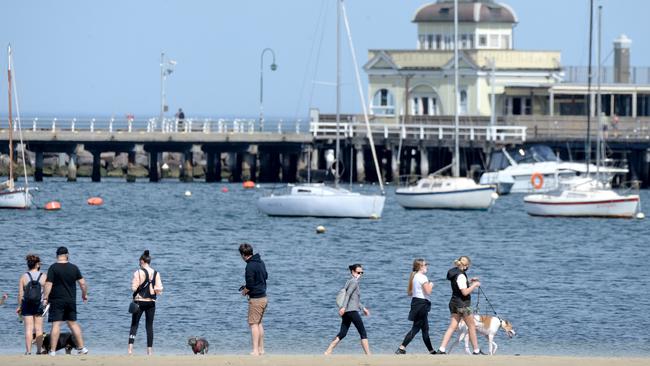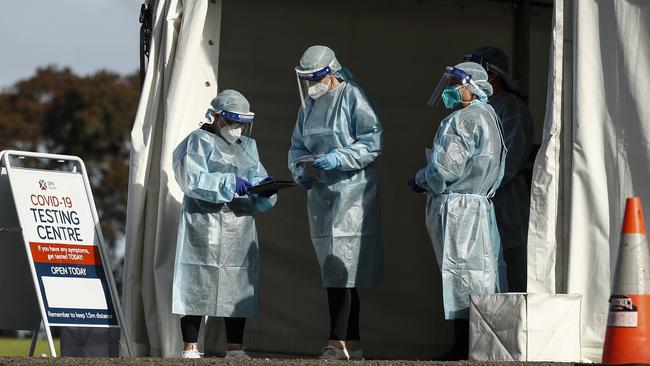14 cases, five deaths; coronavirus outbreak linked to Casey households grows
No Victorians died from COVID-19 on Saturday, with the five deaths reported all taking place before the weekend. It comes as the coronavirus cluster linked to a handful of families in the City of Casey has grown once again, despite health authorities saying it was “under control”.
Coronavirus
Don't miss out on the headlines from Coronavirus. Followed categories will be added to My News.
This coronavirus article is unlocked and free to read in the interest of community health and safety. Get full digital access to trusted news from the Herald Sun and Leader for just $1 a week for the first 12 weeks.
Premier Daniel Andrews said Sunday was “a good day”, as Melbourne recorded just 14 new coronavirus cases overnight.
Sunday has seen the lowest daily increase since 13 cases were recorded on June 19.
But sadly, five Victorians lost their lives, taking the death toll to 761.
The latest victims include two men and two women in their 80s, and a woman in her 90s — all linked to aged-care.
However, all five of the deaths took place before Saturday.
One previous death was reclassified, resulting in a net increase of four deaths since yesterday.
Currently, 94 Victorians are in hospital, with eight in intensive and five on a ventilator.
There are also 743 active cases across the state, 25 of those in regional Victoria.

“There will always be debate on timing … ultimately this is a cause for optimism,” Mr Andrews said. “Today is a good day,” he said.
Metropolitan Melbourne’s rolling 14-day average has dipped to 36.2, but 52 mystery cases remain — a decrease of seven.
Meanwhile, regional Victoria’s average remains stable at 1.8, with no mystery cases.
Melbourne’s figure, if maintained, could trigger the long-awaited winding back of lockdown measures by next week.
The city is set to take its second step from coronavirus restrictions next Sunday, which includes small public gatherings, the phased return of workplaces and reopening of outdoor pools.
Metropolitan Melbourne must reach an average daily case rate of between 30 and 50 cases over the preceding fortnight to trigger an easing of restrictions from September 28.

Mr Andrews said he was “confident” restrictions would be wound back for metropolitan Melbourne but warned that the decision would be made based on data.
“We’re confident that come Sunday, we’ll be able to make some significant announcements because we’ll be in that 30 to 50 band,” he said.
“But that should lead to no sense of complacency. We’ve just got to stay the course.”
And while the Premier said he could not be certain where the state would be by the end of October, he did not rule out revising the road map if case number targets were met ahead of schedule.
“Data trumps modelling,” Mr Andrews said.
The Premier said the first step of restriction easing on September 28 would not be brought forward, but what would happen by end of October was open to review.
HALLAM CLUSTER BALLOONS AGAIN
Concerningly, the Hallam outbreak has grown overnight, with 40 cases now linked to the cluster — an increase of six.
“It just gives you a sense of one person, just a single person, can infect many, many other people,” Mr Andrews said.
“And the contact tracing work has seen us pull that up. There is still, I’m sure, close contacts and others will be very much monitored to make sure that if they exhibit symptoms, that we can further isolate them.
“But they’re all isolated there. We believe that we can pull it up at that number, but again, it’s always subject to and events as they unfold. Whether it’s there for in Colac, where one person ended up infecting through chains of transmission, 25-plus people.”

The Premier stood by the decision not to fine the “Casey cluster” rule-breakers, saying it could jeopardise contact tracing efforts.
“If you fine people for telling the truth, how do we reckon contact tracing would go?”
Mr Andrews asked.
He expressed frustration and anger at families that had broken lockdown rules, but said the “truth was worth everything”.
Patient zero in the cluster may also never be identified, he said.
“We never know where that index case was, that very first person where the first person among these 40 got it from … that’s the nature of having from much more from an historical perspective than a contemporary perspective, we have had so much community transmission around the place that some of those riddles will never be solved,” Mr Andrews said.
ANTI-LOCKDOWN PROTESTERS’ BIZARRE FLASH MOB
An anti-lockdown rally at Chadstone Shopping Centre has come to a rapid anti-climactic end.
A small number of demonstrators gathered outside Coles and sang “You’re The Voice” by John Farnham at 1pm.
Organisers described the Chadstone rally, which lasted less than five minutes, as a “victory” before revealing a second protest location would be announced.
The move to suburban Melbourne comes as hundreds of police flooded across the CBD.
Dozens of officers have been patrolling Queen Victoria Market, the scene of last weekend’s dramatic rally, since early Sunday morning.
An early morning rally was due to start at 7am but failed to take off.
On Sunday’s planned protest, Mr Andrews said: “It can achieve but one thing, the potential spread of this virus.”
“Don’t protest, go home, stay at home, and then you can do all the protesting you like in the future,” he said.
Follow the latest protest coverage here.
HOSPITALS, WORKPLACES DRIVING INFECTIONS
Meanwhile, hospitals and workplaces continue to lead as the main source of COVID clusters in Victoria outside of aged care.
The Footscray Hospital was linked to 13 active cases and the Alfred Hospital to seven, according to Saturday’s DHHS data.
The Vawdrey Australia Truck Manufacturer was linked to seven active cases, while Dandenong Police Station had six.
Residential disability homes have also been a recurrent setting for outbreaks, as Victoria works to bring case numbers under control.
Cases linked to residential care homes appear to have been curbed by the measures, with only two cases recorded in NDIS care homes.

However, the Casey community outbreak remained the largest non-aged care related cluster with 34 cases — 26 active — on Saturday.
Chief Health Officer Brett Sutton said the cluster linked to the five households in the Casey area was “under control” but could still grow.
“We will always look out over the 14-day period when the new cases can emerge – 14 days from the time of last exposure,” he said.
“So there is absolutely a possibility of additional cases.
“What we do know is people isolating appropriately and that close contacts are in quarantine but people have obviously been exposed to the virus and they can develop illness any time up to 14 days after having been exposed.
“Very few close contacts outside of the cluster that is known.”
Prof Sutton said two cases linked to the cluster were in hospital, but the total number of cases in the Casey area had decreased from 74 to 67.
CASH INJECTION FOR MUSIC SCENE
The government announced a $13 million cash injection for the state’s struggling live music scene.
Creative Industries Minister Martin Foley said Melbourne had the highest number of live music venues per capita anywhere in the world.
“It was one of the first and hardest hit and under the road map … it will be one of the last to return,” Mr Foley said.
“To keep these venues going … is at the heart of this package.”
Victorian musicians, managers, promoters, bookers and other workers will also be in line to receive support grants between $4000 to $50,000.
“We want to ensure we can keep pumping out rock and roll and keep pumping out live music for many years to come,” Mr Foley said.
HELP FOR PARENTS STRUGGLING TO PAY CHILDCARE FEES
Victorian parents struggling to pay for childcare will receive hip pocket relief with fee increases put on hold until next year.
Education Minister Dan Tehan will today unveil a $300 million package for families and childcare providers hit by the second wave of the coronavirus in Victoria.
Under the multimillion-dollar plan, families impacted by COVID-19 shutdowns will not have to prove they are working, studying or volunteering to receive subsidies, with the a ctivity test requirement put on hold until April.
Childcare centres that have fewer children will continue to receive a top-up payment worth 25 per cent of pre-COVID revenue until January 31. Currently, Victorian centres can receive payments worth up to 30 per cent of pre-Covid revenue but that support was due to expire on September 28.
Read the full story here.

THE SIGN LOCKDOWN FATIGUE MAY BE SETTING
Locked down Melburnians are moving more frequently around the city each week while restrictions remain in place, with virus hot spots and disadvantaged areas such as Wyndham, Brimbank and Hume among the areas where more people are hitting the road.
It comes as Victoria recorded 21 new cases of coronavirus on Saturday and seven deaths.
New research from University of Melbourne academic Rohan Byrne has modelled each region’s “lockdown compliance” and found the areas most impacted by the virus were among the spots were also leading the way in returning to streets and sidewalks.
Read the full story here.
